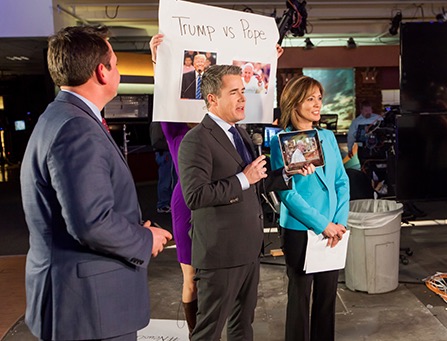Stations Expand Coverage With Facebook Live

On Feb. 18, the power went out at KDVR Denver. Powerful winds had caused the studio to go dark, but Tribune’s Fox affiliate had a 5 p.m. newscast to broadcast. So the station decided to stream the program live on Facebook.
Without access to any video or scripts, everyone had to improvise. All the reporters lined up to talk about the day’s stories with the anchors. The art department made up old-fashioned graphics on white sheets. They pulled in as many working lights as they could.
“We just winged it,” says Holly Gauntt, KDVR VP of news and digital content. “It’s really nice to still have an audience just because we don’t have power. That’s the beauty of our world transitioning to so many platforms. We don’t have the option to say, ‘Just because it’s not on TV means we’re not going to do it.’ We just have to do it differently.”
Facebook has been rolling out Facebook Live since September; it has been open to everyone for about six weeks now. On the mobile app, there is an option to stream a video live instead of posting text or a photo, and viewers can comment and interact while watching the video.
“Local news is one of the areas we’ve seen really taking off,” says Fidji Simo, director of product at Facebook.
More than 20,000 people watched KDVR’s Facebook Live newscast—a number far smaller than the average newscast, but not bad given the abruptness. It was “a hell of a lot easier” to click a few buttons on a phone than get a satellite truck in the parking lot, Gauntt says. And the engagement with viewers is obviously far greater than a newscast on linear TV.
“That experience draws people in closer than you’ll ever get than watching through broadcast, simply because you see a different vantage point,” Gauntt says. “It made people feel like they were part of an experience instead of us telling them what went on. I think it builds fans.”
Broadcasting & Cable Newsletter
The smarter way to stay on top of broadcasting and cable industry. Sign up below
Stations all over the country are turning to Facebook Live. WOKH, Sinclair’s Oklahoma City station, used it to offer election updates on Super Tuesday. Graham Media Group’s WJXT in Jacksonville, Fla., has live-streamed a behind-the-scenes look at how it prepares newscasts. Tribune’s WGN Chicago took to Facebook Live to provide updates, safety issues and closures during high winds several weeks ago.
During the East Coast blizzard in January, Bob Monek, executive producer of digital and social media at WABC New York, streamed a Facebook Live video of a cab driver getting stuck in the snow and people helping him out. It drew 60,000 views.
Monek says engagement and comments go deeper on Facebook Live than other live video platforms like Periscope. It’s one thing to post something on Facebook. “It’s a whole other element when you are live on one of these platforms and getting viewer questions and able to respond and ask them questions,” Monek says. “That interaction is the most tangible benefit we have that we’ve never had before, not at that level anyway.”
Natalie Brand, a political reporter at KING Seattle, regualrly streamed Facebook Live videos, including interviews and rallies, while on the campaign trail in Iowa. When Hillary Clinton made an unexpected trip into a coffee shop before the caucus, Brand pulled out her phone and captured the scene.
With Washington having a relatively late caucus and being a solidly blue state, “we don’t see that type of retail politics that exists in Iowa,” Brand says. She was able to show that with Facebook Live.
“My whole goal as a political reporter is to try to engage people, let them see what’s behind the scenes,” Brand says. “If you don’t catch the segment live on television when it happens, you missed it. Now I can tell viewers you want extra info on the election, local insight or extra analysis from us, just go to the Facebook page.”
Stations are still in the early stages of learning how to take advantage of Facebook Live and other live-streaming social media platforms. There will continue to be experimentation at stations nationwide to innovate and improve.
“People live with phones in their hands,” Gauntt says. “We’ve got to learn to adapt to that audience. The next challenge is trying to figure out how to take Facebook Live a step further. I don’t think that I know what it is yet. I just hope they keep inventing stuff for us to explore.”










